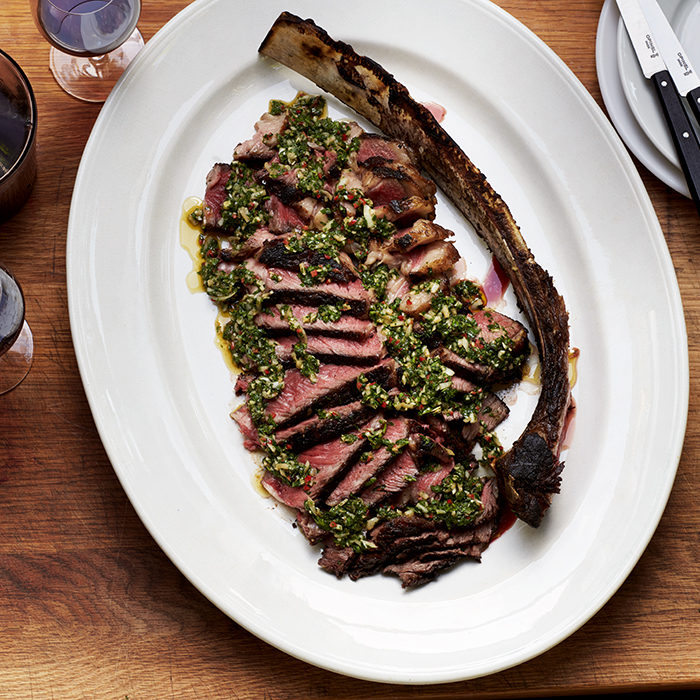Essential ingredients: tomahawk steak
Author: Stewart Turner

We recently did a chef’s choice dinner at No.3 St James’s Street, and I was asked by some of the guests what my ideal, or go-to meal, would be. Mine is a great piece of beef grilled on the barbecue until it’s what we, in the old days, used to call flare and rare – really well coloured and charred on the outside, but lovely and rare on the inside. My go-to cut has always been the ribeye, as it has lovely fat content and – as a great friend of mine from Australia used to say – “no fat, no flavour”.
The tomahawk is essentially a côte de boeuf, but with the bone left long. It’s a real statement cut and has a real wow factor that can’t fail to impress. It’s a big cut that can range from 900g to about 1.4kg so will easily feed a small family, or two to three hardy carnivores.
If you cook thick cuts over too much direct heat, it’ll be black before you’ve got the centre to a nice medium rare, so I’ve started doing what we call a reverse-sear method. You cook using indirect heat over a slightly cooler part of the grill, then once you reached the right internal temperature, finish it over a very high heat to get a lovely charred finish.
Barbecued tomahawk steak with board dressing
- 1 tomahawk steak – about 1.2kg
- Salt and freshy ground pepper
- 4 sprigs of thyme – leaves picked
- ½ red chilli – split and deseeded
- 1 clove of garlic
- 1 small handful of flat parsley
- 2 shallots – peeled
- 10g Dijon mustard
- 15ml Cabernet Sauvignon vinegar
- 45ml olive oil
Start by removing the steak from the fridge and seasoning really well with salt and freshly ground pepper, at least an hour before cooking.
Light the barbecue and, keeping the coals over to one side, cook the tomahawk over the cooler side of the grill, so that it cooks a little bit more slowly. Turn every five minutes or so.
After about 15 minutes, check the internal temperature with a thermometer: you want it to be about 40°C in the centre. This will still be pretty rare, but – as we are going to sear again – we don’t want it too hot or it will be overdone.
While the steak is cooking, chop the shallot, garlic, chilli and herbs on a board, preferably one with a lip or groove around the edges. In a bowl, combine the oil, mustard and vinegar.
Once the steak is cooked, place on top of the chopped herb and shallot mix, cover lightly with foil and allow to rest for about 15 minutes.
To get a really great char, add some fresh coals to the barbecue (I use a chimney starter to get them going quickly, then add to the fire to allow the grill to get really hot).
Give the tomahawk one to two minutes on each side, and another minute on the fat round the outer edge, over the searing hot coals.
Mix the herbs, along with any of the resting juices, into the oil mix and season well. Remove the tomahawk from the grill and carve onto a serving platter. Pour the board dressing over the top and serve.
What to drink
Such an ostentatious cut of beef deserves something just a little bit flashy alongside it. A full-bodied wine packed full of fruit that can do justice to this primal hunk. We’d automatically look to the New World here (although something from the Rhône would work very nicely too): Bedrock’s Old Vine Zinfandel is bold, elegant and complex. This Rhône-style blend from Tablas Creek has bright and plush fruit that will marry well with the flavours here. Equally, Frankland Estate’s elegant, peppered Shiraz from the remote and cool-climate Frankland River would make an excellent partner.


